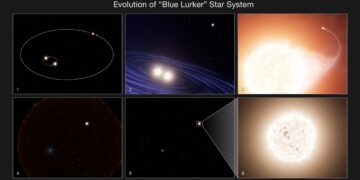The universe is brimming with fascinating phenomena, and the Hubble Space Telescope has once again brought us closer to understanding one of its mysteries. Recently, astronomers uncovered a “blue lurker,” a peculiar type of star lurking inconspicuously in the Messier 67 (M67) star cluster, located 2,800 light-years from Earth.
Unveiling the Blue Lurker
Some stars hide in plain sight, blending in with their neighbors but harboring secrets that only advanced telescopes like Hubble can uncover. The blue lurker star in M67 appears much like any sun-like star in the cluster. However, closer examination reveals an anomaly—its rotation rate is unusually fast, completing one spin in just four days, compared to the Sun’s 30-day rotation. This rapid rotation sets it apart, and further analysis exposed its tumultuous past within a triple-star system.
The term “blue lurker” stems from its subtle blue hue, which results from its rapid rotation and past interactions. Unlike “blue stragglers,” which are bright and conspicuous, blue lurkers blend into the cluster, making them harder to identify. Yet their presence is a testament to the complexity of stellar evolution in dynamic systems.
The Tale of a Triple-Star System
The blue lurker’s extraordinary story begins in a triple-star system, where three sun-like stars were gravitationally bound. Over 500 million years ago, the two inner stars of the system spiraled inward, eventually merging into one massive star. This dramatic event was not just a celestial collision but the start of a chain reaction that would shape the future of the remaining star, the blue lurker.
The merged star grew into a giant, shedding its outer layers in the process. During this phase, the blue lurker, the lone remaining companion, siphoned material from the giant, gaining mass and angular momentum. This accretion spun the blue lurker into its current rapid rotation state. The massive star ultimately burned out and collapsed into a white dwarf, leaving the blue lurker and its companion as a tightly bound binary system.
Why This Discovery is Significant
The discovery of the blue lurker is not just an isolated curiosity; it provides profound insights into the lifecycle of stars and the intricate dynamics of triple-star systems. Studies show that approximately 10% of sun-like stars exist in triple systems, and their evolution often leads to unique and unexpected outcomes.
Understanding the blue lurker’s evolution offers clues about how stars exchange mass, merge, and interact within complex systems. It also underscores the role of gravitational interactions in shaping stars over millions of years. Such systems can produce rare and extraordinary celestial objects, adding to our knowledge of stellar diversity and the processes that govern it.
Hubble’s Role in Uncovering the Blue Lurker
The Hubble Space Telescope was instrumental in unraveling the mystery of the blue lurker. By using ultraviolet spectroscopy, Hubble provided critical data on the companion white dwarf, revealing its unusual properties. The white dwarf is both exceptionally hot, with a surface temperature of 23,000°F, and unusually massive at 0.72 solar masses—traits consistent with a star formed through a merger.
Hubble’s high-resolution imaging and detailed spectral analysis made it possible to trace the evolutionary history of the system, connecting the dots between the blue lurker’s rapid rotation and its interaction with the white dwarf.
How Blue Lurkers Differ from Blue Stragglers
While blue lurkers and blue stragglers share a common thread in their formation—mass transfer—they differ significantly in their appearance and characteristics. Blue stragglers are visibly brighter, hotter, and more massive than their counterparts in the same cluster, making them stand out. Blue lurkers, on the other hand, are subtler, with characteristics that mimic typical sun-like stars. Their blue hue and rapid rotation are the only clues to their unique history.
The blue lurker’s ability to “hide” among other stars makes its discovery particularly exciting. It highlights the subtle complexities that can arise in stellar evolution and demonstrates the need for detailed observational techniques to identify and study these hidden anomalies.
Implications for Stellar Evolution
The blue lurker’s discovery has broader implications for our understanding of stellar evolution. It challenges existing models by showcasing the dynamic outcomes possible within triple-star systems. Mass transfer, mergers, and gravitational interactions can lead to the formation of stars with properties that deviate from traditional expectations.
Lessons Learned
The story of the blue lurker offers several important lessons for astronomers and enthusiasts alike. First, it underscores the dynamic and interconnected nature of the universe, where even seemingly ordinary stars can have extraordinary histories. Second, it highlights the importance of advanced observational tools like Hubble in uncovering the hidden intricacies of the cosmos.
Conclusion
The blue lurker in M67 is more than just an astronomical oddity; it is a window into the complexities of stellar evolution and the intricate dance of gravitational forces. Its discovery, facilitated by the Hubble Space Telescope, exemplifies the power of modern astronomy to uncover the hidden stories of the stars.
More info at: Emily Leiner et al paper



















